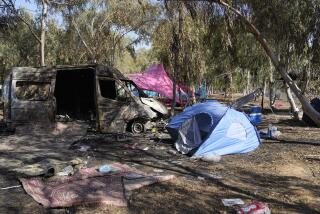All the Women Danced : “The Telling: The Story of a Group of Jewish Women Who Journey to Spirituality Through Community and Ceremony”; (Harper San Francisco: $18; 216 pp.)
- Share via
Political discussions, poetry readings and the binding of friends with hot-pink polyester fabric are far from the makings of the traditional Passover seder, the ritual meal organized around the reading of the haggadah (Passover prayerbook).
But for more than 15 years, Gloria Steinem, Letty Cottin Pogrebin, Bella Abzug and other feminists have turned these activities into a Passover tradition in response to Judaism’s traditional patriarchy, as New York author E.M. Broner explains in her latest book, “The Telling: The Story of a Group of Jewish Women Who Journey to Spirituality Through Community and Ceremony”; (Harper San Francisco: $18; 216 pp.)
Both a historical overview and an instructional guide, “The Telling” details how these women come together to commemorate the ancient exodus of Israelite slaves from Egypt. Each year at Passover the “Seder Sisters and Mothers” and their (usually) female guests spend an evening reading from a haggadah co-authored by Broner.
The seders are both the same and different each year because Broner and her friends combine ancient rituals with feminist commentaries, songs and seemingly unprecedented activities like the polyester ritual. Broner explains: “We sit in a circle, each with her own booklet, reading together. A group needs a written guide from which there can be excursions, preoccupations with other themes, and then return (sic).”
Those themes, which traditionally focus on spiritual liberation, have ranged from the veiling of women in Iran and “the omission of women from history” to wisdom passed from mother to daughter and Black/Jewish dialogue. Once, the group created a sculpture to represent their personal histories: “In 1988 . . . Phyllis (Chesler) suggested we build a model. Lilly (Rivlin), the visualist, wanted photographs. So, to a curious creature, begun with someone’s mother’s hat affixed on top of a coat rack, were added beads, necklaces, snapshots of our past. ‘She’ stood in the corner, imperiously hatted, regarding our ceremony.”
There are many other variations from the standard seder. Traditionally, only male leaders ritually wash their hands, but among Broner and company the women rinse and dry each other’s. Many of the women wear yarmulkas, the skull caps typically worn by observant Jewish men in reference to God. The group also sings to Miriam, the sister of Moses, as an alternative to the prophet Elijah, whose memory is traditionally invoked not only at the seder but at the end of every Jewish shabbat or sabbath.
In the Bible, it was Miriam who led the Israelites in celebration after they miraculously crossed the Red Sea. In “The Telling,” the women remember Miriam with their own poetry and songs as well as those of the growing numbers of women who are becoming rabbis and cantors. Among them are Geela Rayzel Robinson Raphael, a student at the Reconstructionist Rabbinical College outside Philadelphia, whose song about Miriam is included in Broner’s haggadah: “And Miriam took her timbrel out and all the women danced. . . .”
To be sure, “The Telling” has its flaws--occasionally clumsy prose and a confusing structure. But it succeeds, nevertheless, in celebrating both the liberation of Jewish women from frequent exclusion in their tradition and of all women from subservient and disenfranchised positions in society.
More to Read
Sign up for our Book Club newsletter
Get the latest news, events and more from the Los Angeles Times Book Club, and help us get L.A. reading and talking.
You may occasionally receive promotional content from the Los Angeles Times.










